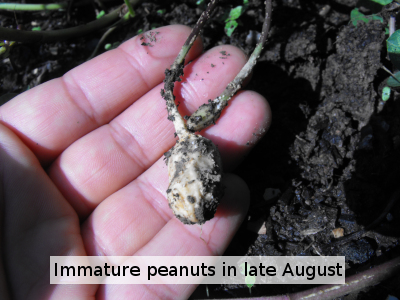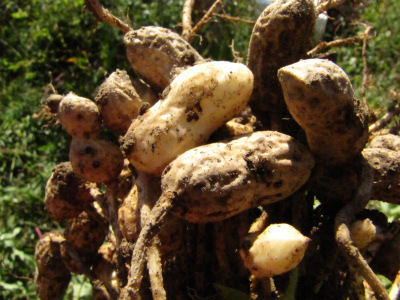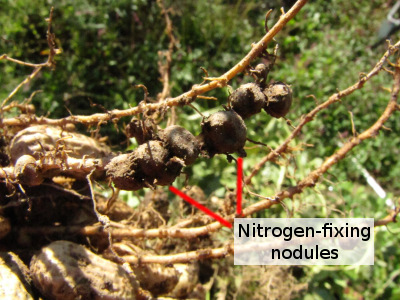
When to harvest peanuts
 Figuring
out when your peanuts are ready is a lot like deciding when
to harvest sweet potatoes. First, check the days
to harvest. We grow one of the few varieties with a short enough
season to mature in zone 6 (Early Spanish --- 100 days to harvest),
which means that we could potentially dig our peanuts anytime after the
first of September.
Figuring
out when your peanuts are ready is a lot like deciding when
to harvest sweet potatoes. First, check the days
to harvest. We grow one of the few varieties with a short enough
season to mature in zone 6 (Early Spanish --- 100 days to harvest),
which means that we could potentially dig our peanuts anytime after the
first of September.
Various websites
admonish you to wait until the leaves on your peanuts are starting to
yellow, but it's now nearly a month after our peanuts are supposed to
be ripe, and we haven't seen any yellowing. However, the plants
did mostly stop blooming a couple of weeks ago, which I suspect is a
good sign that they're nearing maturity.
 If
you think the date is close enough, dig up a test plant. To dig
peanuts, sink your shovel straight down into the soil about six inches
away from the plant's stalk and lever the pointed end toward the plant,
loosening the soil underneath. Then gently lift the plant out of
the soil. If the ground is clayey and too wet or too dry, you'll
lose peanuts in the process, so it's best to make sure your soil is
moderately damp before digging a test plant.
If
you think the date is close enough, dig up a test plant. To dig
peanuts, sink your shovel straight down into the soil about six inches
away from the plant's stalk and lever the pointed end toward the plant,
loosening the soil underneath. Then gently lift the plant out of
the soil. If the ground is clayey and too wet or too dry, you'll
lose peanuts in the process, so it's best to make sure your soil is
moderately damp before digging a test plant.
Shake off any clods of
dirt, then take a look at the beautiful peanuts clustered around the
plant's roots. There will definitely be a few paler peanuts that
aren't yet fully formed, but if the majority are full-sized (like in
the photo above), you're probably in good shape. To make sure,
crack a shell  open
--- are the nuts filling up the whole shell inside? If so, your
peanuts are ready to dig. (Take a minute while you're peering at
the roots to notice the nitrogen-fixing
nodules lower down --- pretty cool, eh?)
open
--- are the nuts filling up the whole shell inside? If so, your
peanuts are ready to dig. (Take a minute while you're peering at
the roots to notice the nitrogen-fixing
nodules lower down --- pretty cool, eh?)
Dig your whole patch
just like you dug the test plant, then put them on a screen or in
another airy location to dry. Don't eat any of your bounty yet
(including that test peanut!) Fresh peanuts contain a mild toxin
and need to cure for a few days before they can be eaten. Once
you've waited the requisite time, check out my post about making your own
peanut butter!
Want more in-depth information? Browse through our books.
Or explore more posts by date or by subject.
About us: Anna Hess and Mark Hamilton spent over a decade living self-sufficiently in the mountains of Virginia before moving north to start over from scratch in the foothills of Ohio. They've experimented with permaculture, no-till gardening, trailersteading, home-based microbusinesses and much more, writing about their adventures in both blogs and books.
Want to be notified when new comments are posted on this page? Click on the RSS button after you add a comment to subscribe to the comment feed, or simply check the box beside "email replies to me" while writing your comment.
- Remove comment
